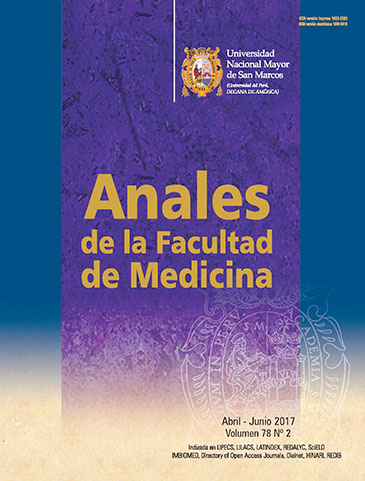Obesity in Peru
DOI:
https://doi.org/10.15381/anales.v78i2.13214Keywords:
Obesity, Dietary Patterns, Physical Activity.Abstract
Obesity is a chronic disease presenting in all population groups and with a tendency to a time-driven increase. The highest prevalence occurs in the adult population followed by the school, pre-school and adolescent group. Those living in urban areas, women and those not considered as poor are the most affected. Obesity is already present throughout the world and has been declared the epidemic of the 21st century. Its presence is related to diseases such as diabetes mellitus 2, hypertension, dyslipidemias and some types of cancer. Complications such as insulin resistance and metabolic syndrome are already present in adolescents. Factors that condition changes in lifestyles (dietary patterns and sedentary lifestyle) are increasingly prevalent and with a trend for more presence in the future, which makes the obesity panorama look bleak. Despite all the recommendations made by international organizations, in particular the World Health Organization (WHO), and the measures taken by the Peruvian state, especially the law on the promotion of healthy eating for children and adolescents, the prevalence of obesity continues to rise. It is necessary to raise awareness among the population that obesity is a disease that leads to many complications that seriously compromise health. It is necessary to follow the recommendations to a healthy diet and promotion of physical activity, and commit people and institutions to a healthy lifestyle, in an effort to provide good health to the population.Downloads
Published
2017-07-17
Issue
Section
Simposio
License
Copyright (c) 2017 Jaime Pajuelo Ramírez

This work is licensed under a Creative Commons Attribution-NonCommercial-ShareAlike 4.0 International License.
Those authors who have publications with this magazine accept the following terms:
- Authors will retain their copyrights and guarantee the journal the right of first publication of their work, which will be simultaneously subject to Creative Commons Attribution License that allows third parties to share the work as long as its author and its first publication this magazine are indicated.
- Authors may adopt other non-exclusive licensing agreements for the distribution of the version of the published work (eg, deposit it in an institutional electronic file or publish it in a monographic volume) provided that the initial publication in this magazine is indicated.
- Authors are allowed and recommended to disseminate their work over the Internet (eg: in institutional telematic archives or on their website) before and during the submission process, which It can produce interesting exchanges and increase quotes from the published work. (See El efecto del acceso abierto ).
How to Cite
1.
Pajuelo Ramírez J. Obesity in Peru. An Fac med [Internet]. 2017 Jul. 17 [cited 2025 Jun. 19];78(2):179-85. Available from: https://revistasinvestigacion.unmsm.edu.pe/index.php/anales/article/view/13214



